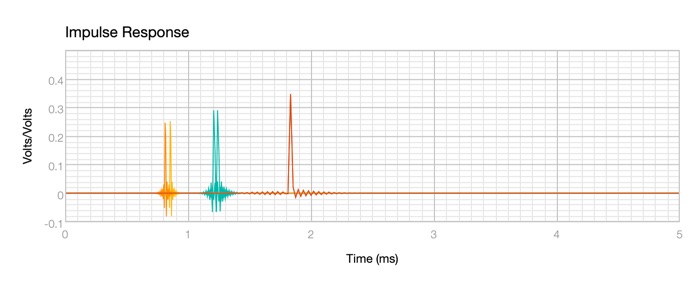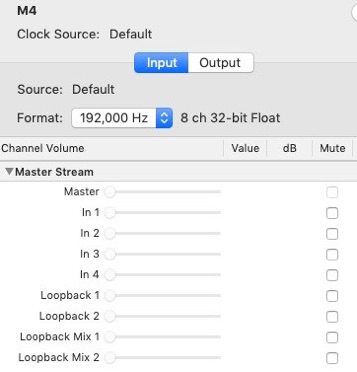MOTU M4 USB Interface

MOTU M4 Interface
Wednesday, March 17, 2021

A recent addition to the gadgets hereabouts is a MOTU M4 USB-C audio interface. These are kind of hard to get hold of. They’re usually sold out at dealers. I finally got one. The thing that leaps out at you is the screen on the front with high resolution meters instead of the more usual red and green LEDs. Turns out they’re made about 5 miles away from home in Austin. Made in USA.
The basics: four channels, two mic preamps with combo jacks for XLR mic or TRS line or instruments. Channels 3 & 4 are balanced 1/4” TRS line level inputs with no level controls, optimized for studio levels of +4 to +18dBU. There are both balanced TRS and unbalanced RCA outputs on the rear. There is MIDI I/O and an ON/OFF switch. Power is from the USB buss. The front panel has the usual controls including a monitor mix for input and computer. It’s well equipped. All the knobs are metal and feel smooth and sturdy. Nothing flimsy or plasticky feeling. For more details, see MOTU’s website. https://motu.com/en-us/products/m-series/m4/ and Audio Science Review. https://www.audiosciencereview.com/forum/index.php?threads/motu-m4-audio-interface-review.15757/
Here’s the rear panel:

So how does it work? So far, very well. If I had plugged the “flashlight” mic into this box instead of the Focusrite, I might have thought it was quiet enough, and not discovered its weaknesses. Having inputs and outputs with fixed levels (no volume controls) like channels 3 & 4 is handy for measuring things. Once those inputs and outputs are calibrated, there is no need to do another calibration before every test session.
Here are a few measurements. First, over all frequency response from line out to line in:

48KHz
96KHz
192KHz
Flat and extended on both inputs and outputs. The line ins and outs are DC coupled, so response extends to DC. You could record or program control voltages for an analog synth or robotics. I think this interface will be useful measuring the older interfaces around here.
Distortion. Again red is 48KHz sampling, blue is 96, and orange is 192K.

This is interesting. Two runs at each sampling rate. 48K in red, offers the lowest 3rd harmonic (short dashes) distortion as expected, because the Nyquist filter has to cut off everything above 24KHz, and 1/3 of 24KHz is 8KHz, so there is little energy up there. The surprise is that 2nd harmonic is also low. 3rd harmonic is always higher than 2nd in this gadget, meaning that positive and negative going signals are equally distorted. Second harmonic results when positive and negative signals are unequally amplified.
The blue traces for 96K sample rate show the highest distortion. Perhaps the filters are less effective at this frequency? I haven’t seen an explanation of the effect.
The orange traces for 192K show the least 2nd harmonic, and slightly less third than at 96K. So perhaps this interface will be happiest at 44.1/48 or 176.4/192. In any case with distortion better than 100dB below 0dBu, it is inaudible.
Another look at the distortion spectrum at 1V in & out at 1KHz, 192KHz sampling:

Looks good, but I haven’t measured others for comparison. We will compare as I check out others.
Lastly, group delay over frequency. If there are phase problems, they’ll show up here.
192
96
48

Nothing to see here. I think we can give the A/D and D/A converters a passing grade.
Interestingly, this is one of the few interfaces that uses 32-bit converters. The M4 uses an AKM AK544VN 32-bit 768KHz 4-channel ADC and an ESS ES9016S 32-bit 8-channel DAC. Most small interfaces use a stereo combo ADC/DAC chip.

Another interesting feature is the virtual loopback inputs which allow you to record the output of your computer along with a mic or line. Useful for adding Skype audio to a webcast or recording sound from the web without using something like SoundFlower.
The M4 is USB Audio Class Compliant, so it doesn’t need drivers with MacOS or iOS devices. There is a driver for MacOS which enables 32-bit Floating Point, adds Loopback features, and decreases I/O latency. Without the MOTU driver, MacOS and iOS built-in Audio Unit drivers provide 24-bit I/O.
I haven’t tested it on Windows or Linux. Sorry.
All in all, the MOTU M4 is a capable performer. No frills or “magic legacy” buttons, but it covers the basic functions of a stereo interface with a couple of extra line ins and outs, and does it well.
THD just under 0.001% looks good. S/N from +16dBu to the noise floor around -120 is fine.
How about impulse response? How much delay, and how much pre- and post-echo?


